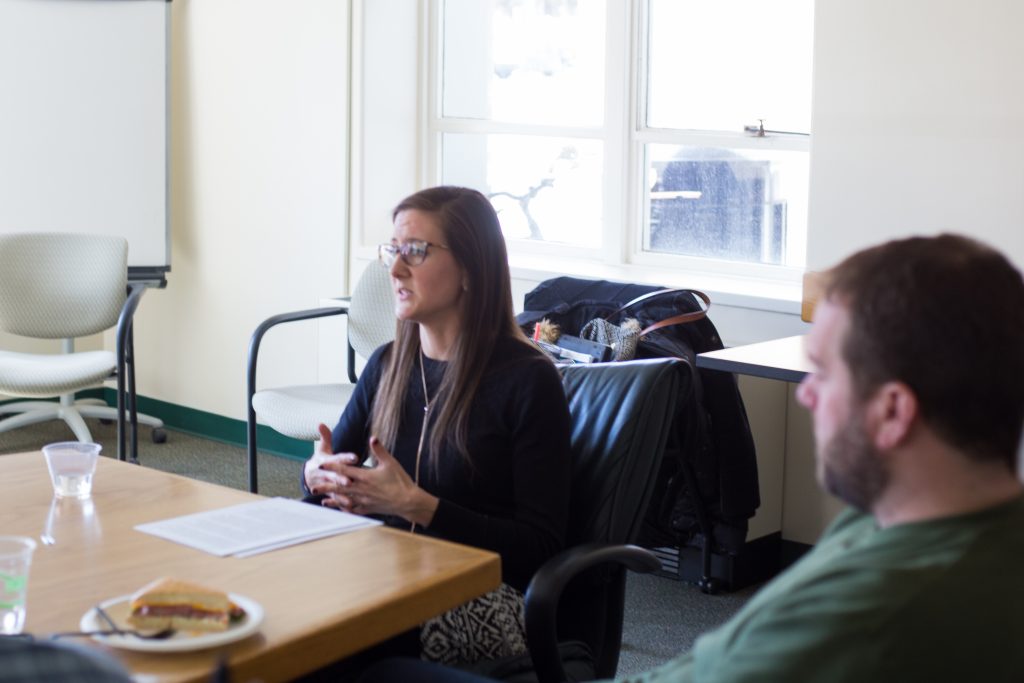
The state of homelessness in Binghamton, where approximately one dozen individuals spend the coldest nights without shelter, according to representatives from the Southern Tier Homeless Coalition (STHC), was addressed at a talk held in the Couper Administration Building on Thursday afternoon.
The talk, hosted by the Transdisciplinary Area of Excellence in Sustainable Communities, invited Rebecca Rathmell, coordinator for the STHC, to discuss her organization’s operations to combat homelessness in the area. As the designated Continuum of Care, a local planning committee the government uses to coordinate and allocate its anti-homelessness funding, the STHC, a collaborative nonprofit organization with a mission to provide solutions for homelessness in New York’s Southern Tier, is specifically responsible for organizing and working with member agencies to aid affected communities.
According to Rathmell, more than 1,500 individuals accessed emergency shelter last year in Broome County, and the coalition had observed a 100 percent or higher utilization rate of its support resources at multiple levels, an increase from previous years. Although creating emergency shelter is where the STHC’s mission begins, Rathmell said their end goal is to transition homeless families and individuals into permanent housing.
“More than anything else, homelessness is a housing issue,” Rathmell said. “The only thing that is going to solve homelessness is housing.”
Rathmell said the STHC is currently working to improve the accessibility of its programs by collecting and analyzing data on their effectiveness, particularly concerning equal access across racial lines.
“We are seeing that there could be some disparity in movement to some of the more permanent supportive housing programs,” Rathmell said. “I think what we’re anticipating is probably that access to the most crisis aspects of local projects — emergency shelter will be relatively comparable across the racial spectrum, but we are seeing that there could be some disparity in movement to some of the more permanent supportive housing programs.”
While housing is considered affordable if payments come out to less than a third of monthly income, on average, extremely low-income households can spend up to 92 percent of their monthly income just to pay rent, according to Rathmell. Government programs, such as Section 8, attempt to subsidize housing for these low-income households, but with funding limitations, there are often waitlists with long wait times. When prospective tenants are accepted, it doesn’t necessarily mean they’ll have permanent housing. Rathmell said many landlords may refuse to rent to them if they know they are assisted by such a program, a practice that has only been recently declared illegal with an amendment to the New York State Human Rights Law during 2019 budget negotiations.
“An estimated third of apartments that are locally subsidized by the department of social services indicate some kind of home health hazard,” Rathmell said. “The Department of Social Services is not mandated in any of its directives to determine the habitability of the apartments they subsidize.”
In Binghamton, housing is also complicated by a large student population. Rathmell said that while the supply of premium student housing in the area has already reached its demand, new development seems to continue to target this sector of the market, despite the need for new affordable housing. Binghamton University’s latest efforts include renovating areas of Johnson City around their new Health Sciences Campus, which opened last fall.
Homelessness is not a new issue for Benjamin Levine, a senior majoring in geography, who has previously worked with the coalition to collect population data on the local homeless community. Levine said the talk helped illustrate the problem and its connection to the University, but he still has questions on what is known about those on the precipice of homelessness — not yet on the streets, but close to being there.
“We were going around to known and suspected locations that those rough sleeping would reside,” Levine said. “I was going to ask if there had been any studies regarding childcare or if the coalition does anything regarding near homelessness.”


